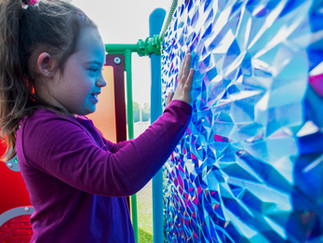All About Inclusive Design
- Shana Friesen

- Apr 28, 2021
- 6 min read
Updated: Sep 10, 2021

Accessible, Inclusive, All Abilities, Playground For All...these are terms that are tossed around a lot when designing a playground. Do you know the difference? Questions about designing inclusive playgrounds come up quite often with our clients and colleagues. Sometimes terminology can be tricky to understand, so we want to clarify the definitions of these terms and give you a resource to view when you have questions. Along with this Blog, we've compiled many resources on our website so you can review, educate and reference when needing more information.

What is an Accessible Playground?
An accessible playground allows kids with or without disabilities to access and use a variety of playground equipment. It also invites parents, caregivers or older siblings with disabilities into the play area to supervise children or take part in the fun.
The accessibility guidelines in the Americans with Disabilities Act (ADA) require most new playgrounds to comply with the standards they set forth. They also require existing playgrounds undergoing alterations to comply.
All kids should be able to travel freely on smooth pathways and ramps, use grab bars with ease and be able to move from one piece of equipment to the next safely.
While creating an Accessible Playground seems like enough for children with these needs, there could be challenges and limitations brought on by certain accessible play equipment that could create a sense of isolation or feeling like they may not be able to participate in the same way as others. An accessible playground should go beyond just looking at the ADA requirements. A truly inclusive space needs so much more!
What is an All Access Playground?
Most new or renovated playgrounds must adhere to specific requirements stemming from the Americans with Disabilities Act (ADA), but ADA compliance is only the bare minimum. An ADA-compliant playground might have an accessible entrance and transfer stations (spaces where a child in a wheelchair can pull themselves onto a play structure) but it's only required on 50% of the playground. Surfacing can be another issue hindering full access to a playground. Engineered wood fiber (EWF) surfacing has great impact qualities and meets requirements for accessibility according to the ADA standards, but while this is technically ok per the standards, anyone with a wheelchair bound child knows how difficult it can be to move across it easily. EWF can make moving around on the playground harder which limits children in mobility devices from truly experiencing the entire playground and therefore missing out on crucial socialization and playtime with other able-bodied children. Installing unitary rubber surfaces like pour-in-place rubber or rubber tiles exceeds ADA standards but for a child in a mobility device it makes moving around the playground so much easier.

In order to make sure these children are included, it's important to make sure 100% of the playground has accessible ramps, entrances, transfer stations and surfacing to allow disabled children be included in every part of the playground. There are more than three million disabled children in the United States and we need to make sure they don't miss out on crucial play opportunities. Many designers and city administrators have begun making efforts to go beyond basic access and ensure All Access for kids with various disabilities through inclusion.
What is an Inclusive Playground?
In addition to being accessible, your playground should be inclusive. An inclusive playground allows children of all abilities and developmental stages to play in the same space and create a nurturing environment for all. Other terms for Inclusive Playgrounds are Universally Accessible, Universally Designed, Sensory-Rich, All Abilities or Playground For All.
No one deserves to feel left out. Inclusive playgrounds take the idea of accessibility and bring it many steps further to not only make playgrounds fully accessible, but build the equipment that can be used by truly everyone or provides alternatives in addition to traditional playground equipment so that everyone has an opportunity to participate. An inclusive playground considers the needs of all kids and incorporates play equipment that addresses those needs which promotes growth and joy. For example, children with autism spectrum disorder (ASD) or sensory processing disorder sometimes need to regroup in a quiet, cozy space. To build an inclusive playground, you might incorporate a comfortable, quiet area for kids with ASD to escape the commotion without feeling isolated. Experts estimate one in 59 children has ASD. An inclusive playground sends kids with ASD and other disorders the message that they shouldn’t have to play alone.
Five Fundamentals in an Inclusive Playground Design
Key fundamentals of an Inclusive Playground Design is to encourage children of all ages and abilities to play, to be challenged, and to have fun together. Our Inclusive Playground Designs support the following FIVE Fundamentals:
As you can see, Inclusive Playground Design goes beyond wheelchair-accessible playground equipment only; truly inclusive playground equipment includes systems and components that allow all children to play together in a rich and engaging way. In an inclusive play space, children of different abilities can play together, ensuring no one is left out.
Elements of Play
Our team of in-house designers want to make it easy to know what inclusive elements they've added to the design. The Elements of Play board was developed to present our clients with a visual that lists out all of these inclusive and ADA elements to help them better understand the reason why we have included them. See the example below!

Why Make Your Playground Accessible and Inclusive?
Children with disabilities benefit from free, unstructured play just as other children do, and they have a right to equal opportunities. An inclusive playground removes barriers between kids, despite any differences, and gives them the chance to play and grow together as they should. The benefits of an inclusive and accessible playground seem endless, but here are a few to consider.

Help kids gain understanding ~ When all kids get to play together, they gain a better understanding of the world and learn to appreciate and accept differences and similarities.
Create a stimulating play environment ~ An inclusive and accessible playground offers a wide variety of exciting activities all kids can enjoy.
Help kids build self-esteem ~ A positive, enriching playground helps kids develop a sense of identity, and boosts their confidence and self-esteem as they learn new skills and make friends.
Help families spend time together ~ Adults with disabilities can spend time with their kids or grandchildren in an accessible and inclusive playground.
Build a better future ~ Inclusive and accessible playgrounds teach kids to value equality and fairness, which has long-lasting positive effects on the community and helps create an inclusive society where everyone enjoys equal opportunities.
Steps Toward Making a Playground Accessible & Inclusive
Making a playground accessible and inclusive does not have to be complicated or unaffordable. There are plenty of resources available to provide guidance and funding assistance. Also, many playground structures already have inclusivity and accessibility in mind. Nevertheless, it’s understandable if you feel overwhelmed by all the options and regulations. Rest assured, you don’t need an enormous budget or space to make your playground fun for everyone. Let us help you start the process.

Evaluate your playground by asking yourself the following questions:
Can kids and adults who use wheelchairs or mobility devices easily access the playground and equipment?
Are there deterrents such as slopes or narrow paths making accessibility difficult?
Can kids of all abilities use playground equipment such as slides, swings and climbers?
Can all kids play side by side?
Are paths level and smooth, so kids in wheelchairs can easily move about?
Is there enough shade to protect kids and their caregivers from the sun?
Are there rest areas for parents and guardians?
Are there activities that engage the senses in an interesting mix of shapes, textures and sounds?
How many accessible ground-level play activities and elevated play activities do you have?
Do you have ramps, berms or other ways to make it more accessible?
Can all playground users enter the playground using the same route, so no one feels excluded?
To make sure your playground is ADA-compliant, consult the 2010 ADA Standards for Accessible Design published by the Department of Justice.

Your top priority is to make your playground safe, fun and challenging for everyone, all in the same play space. That means considering the unique needs of all kids. For example, you might take the following into account:
Adding sensory activities: Children with ASD often feel over or understimulated, and either need a quiet place to escape to or the option to engage in activities that stimulate their senses. Make sure to include a mix of both calmer areas and sensory-rich activities that may involve music, lights or spinning motions.
Boosting accessibility: Think about how children will access play equipment. You might need to add ramps or transfer systems so all children can enjoy slides, bridges and other pieces. Consider activities that will engage all children physically and help them build strength and coordination. Also, consider how much effort a child will have to put into reaching equipment. It should never be exhausting to play!
Creating social space: Make sure to include activities and equipment all children can use at the same time, so they get the chance to interact and socialize.
The entire playground should offer many opportunities for kids to develop cognitive, physical, social and sensory skills. Consider where your playground needs the most improvement and set realistic goals. Step by step, you can build an accessible and inclusive playground all the kids in your community will enjoy.
Contact Us Today!
Want to learn more about Inclusive Design? Contact us today to schedule a consultation to see how you can incorporate inclusive design into your next project!







































Comments